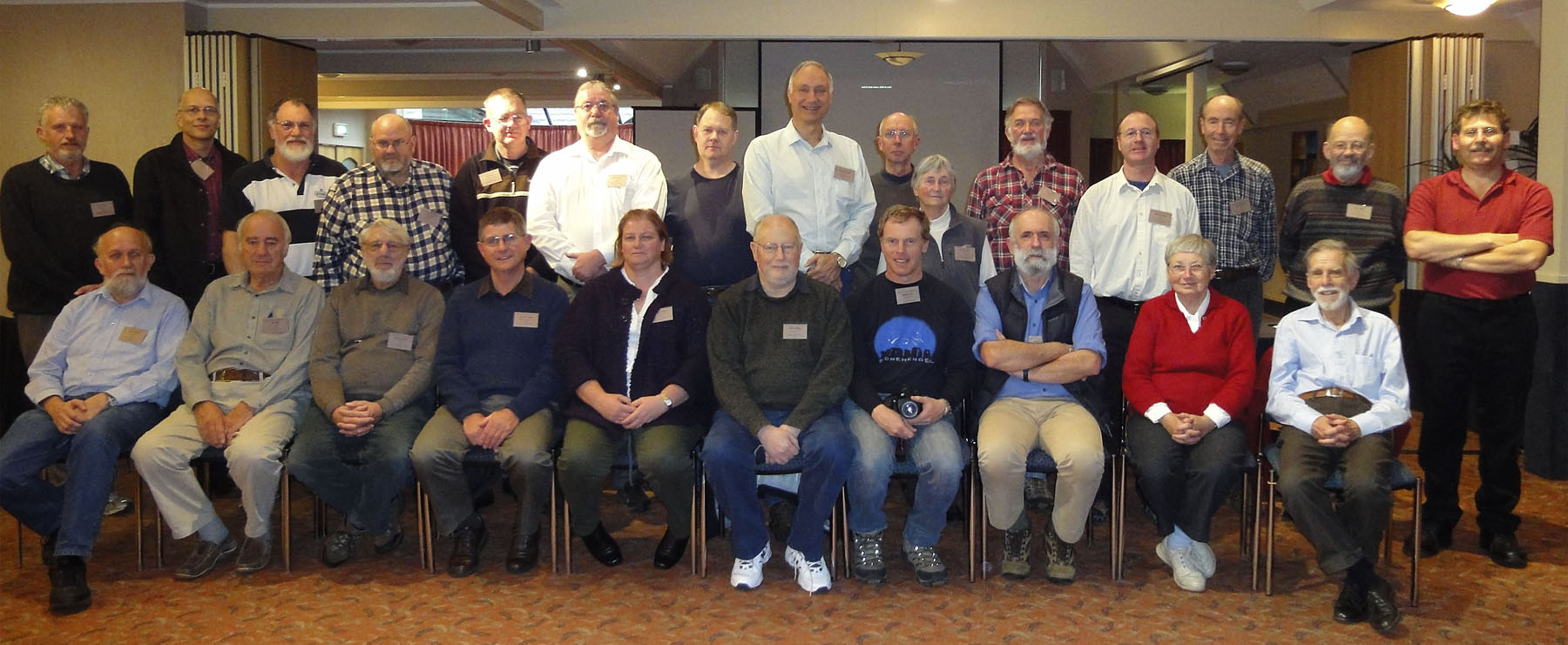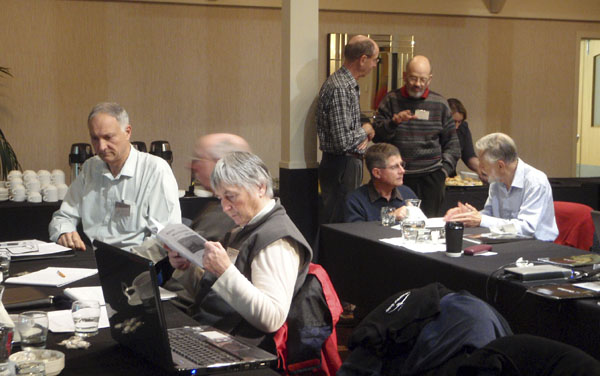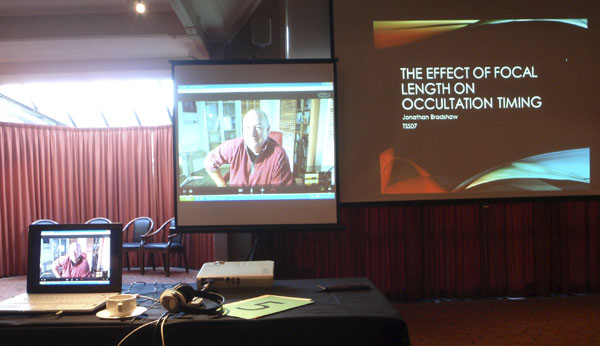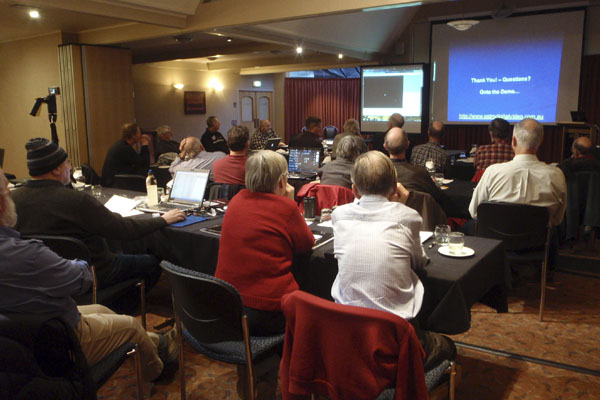|
|
 |
The Seventh Trans-Tasman Symposium on Occultations (TTSO7) was held in Invercargill, New Zealand, following the annual conference of the Royal Astronomical Society of New Zealand (RASNZ). Twenty six participants (eighteen New Zealanders and eight Australians) met over two days, the 27th and 28th May, 2013, while the weather delivered an early wintry blast of hail, sleet and snow outside. An additional three participants from Australia presented their talks via Skype or in a pre-recorded format.
The talks presented during the symposium comprised a mix of basic concepts and procedures, reports of interesting results and experiences from the last year or so and the latest developments in equipment.
After a welcome from Graham Blow, Director of the RASNZ Occultation Section, Steve Kerr started the meeting with an Introduction to Occultations, followed by TTSO7 convenor Murray Forbes who discussed where predictions for occultations could be obtained. Steve Russell then showed how to analyse an audio recording to extract times of events, including some good tips on what features to look for in a digital voice recorder. Brian Loader encouraged the continued observation of lunar occultations, especially since they are such a good way of finding and confirming double star suspects. He followed up this presentation after lunch by showing how to use the latest version of LiMovie to analyse and present observation results for reporting. John Talbot then discussed reporting asteroid occultations, including the new file naming conventions for our region to make archiving observation reports easier. He also requested that positive results involving double stars be sent as two separate reports, one for each component. Bill Hanna, a relative newcomer to occultation astronomy, rounded out the session with a summary of his activities to date and what it is like to observe from Alice Springs, right in the middle of Australia.
The end of the first day was focused on video observing, with Tony Barry giving an Introduction to the Technical Aspects of Video, followed by a good discussion on how the level of gamma used can affect the ability to measure the brightness of stars. Steve Kerr returned to give an Introduction to Integrating Video Cameras, then Tony Barry and Dave Gault presented the latest form of the Astronomical Digital Video System they have been developing with Hristo Pavlov. (http://www.astrodigitalvideo.com.au/). Their original concept of an all-in-one box has now morphed into a purpose built GPS receiver and timing device supplied with software which runs on an Ubuntu (and eventually Windows) platform, with a Flea3 (or alternate) video camera purchased separately by the user. Files are saved in the new ADV format, which will not be corrupted or lost if a connection is broken during recording. The ADV format can be analysed using version 3 of Hristo’s Tangra software. (http://www.hristopavlov.net/). Everyone was interested to see how the project was coming along and Dave and Tony were kept busy with queries and discussion until the end of the scheduled time slot. The foul weather outside encouraged many participants to linger inside the warm hotel and an impromptu social session over drinks and dinner in the house bar rounded out the day.
The second day began with John Talbot’s summary of successful results over the past year by observers in our region. Of note was the possible discovery of a double star during an asteroidal occultation, and a rare trans-Pacific success involving Steve Kerr in Queensland and observers in North America. A pre-recorded talk by John Broughton on determining the dimensions of asteroids from occultation observations highlighted that eighty two percent of observations are currently represented by only a single chord, so John emphasized the benefits of two or more observers attempting a predicted event, or the deployment of unattended stations wherever possible. Although not related to total lunar or asteroidal occultations Martin Unwin then led us through his attempt to record and analyse the most recent transit of Venus in June 2012, which included inviting the local school along to experience the rare event in progress. Tony Barry returned to discuss the story behind the setting up of SEXTA, an array of LEDs similar to the device Gerhard Dangl uses to evaluate integrating video cameras, that was developed to test the workings of the ADVS. Greg Bolt then talked about his experience in using SEXTA to evaluate the accuracy of the ADVS, before Brian Loader ran through the steps to report lunar occultations using Occult.
The last presentation before lunch was a discussion session led by the author on the newly launched “Observing Occultations by Video: A Beginners Guide.” This “beginner’s manual” is the result of two years work, and seeks to comprehensively describe how to capture occultations using video. It includes how to acquire the necessary equipment, prepare for and capture occultation events, the use of video time insertion units, and how to reduce and report results. The genesis of the manual was the realisation that while the introduction of video cameras for recording occultations increased the accuracy of timings (particularly for short duration events) and allowed for multiple stations to be deployed unattended, it was nevertheless quite a daunting change in technology for some. Feedback on this first edition is requested as quickly as possible (please send to the author of this article) and it is hoped that a revised edition will appear shortly. Copies of the manual can be downloaded here.
During the lunch break we were treated to a video of the recent annular solar eclipse that occurred over northern Australia only two weeks before the symposium. This was recorded by Steve Kerr, who travelled up to the Gulf of Carpentaria to catch it, and Steve’s presentation was followed by a video of the transit of Venus captured by Martin Unwin, which complemented his talk from earlier in the morning. After the break John Talbot summarised his talk from the main RASNZ conference on the Jovian Extinction Events which he observed during 2012. This was followed by Murray Forbes who recounted an unfortunate series of events during a grazing occultation over central New Zealand last September when nearly every one of the participants had a tale of woe of to tell. John Talbot returned to give a run-down of how he pre-points his telescope to catch an event, and then in a pre-recorded talk, Chris Chad from Australia described his experience with a Samsung security camera and other similar cameras he has been trialing for occultation work. The Samsung camera, with the IR filter removed, has been quite successful for him.
For the final session of the symposium Jonathan Bradshaw joined us via Skype from Brisbane, Australia, to talk on the effect of focal length on occultation timing. Jonathan’s message was essentially “less focal length is more signal.” While larger apertures can generally see fainter magnitudes, limiting magnitude can be maximised by reducing the focal length of the telescope. Following this Graeme McKay described the discrepancy he had discovered in the recorded times from a video feed split between a digital video recorder and a recording made direct to his computer via a framegrabber. He did not have an answer as to why this was occurring but wanted to alert us to the effect. Dave Herald was the last formal speaker for the symposium with a summary of notable occultation events observed around the world since January 2011. To finish we had a short free-form discussion session, which ranged from the timing of future symposiums, to questions about the availability of equipment and how to make reporting observations easier. David Herald also urged us to look at improving our outreach activities and emphasised that even with all the large telescopes available today the occultations recorded by amateurs using modest telescopes can still outperform professional instruments in terms of resolution.
As Graham Blow and the convenor Murray Forbes closed the symposium, Brian Loader paid tribute to Graham, who started the RASNZ Occultation Section in 1977. Graham has inoperable cancer and due to his declining health does not expect to be able to travel to these meetings in future.
The next symposium, TTSO8, will be held in conjunction with the twenty sixth National Australian Convention of Amateur Astronomers (NACAA XXVI) in Melbourne, Australia, over 18-21 April, 2014. Details for this conference, which is held every second year over the Easter weekend at different locations around Australia, can be found at www.nacaa.org.au.
 |
 |
 |